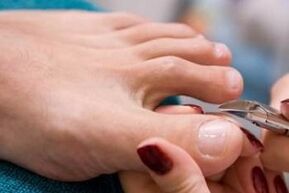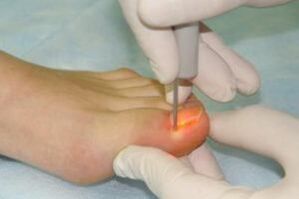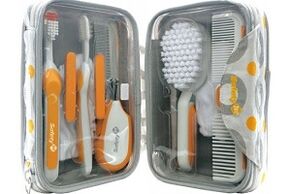Fungal nail infections are generally considered not harmful to human health.Onychomycosis (fungal infection of the nails) occurs with many people for a large part of their lives but often goes unnoticed because there are no acute symptoms.But this does not diminish the importance of treatment for such patients.In addition, everyone should imagine what a fungus-affected nail plate looks like in order to independently diagnose the pathology.
Fungal microbial infection

Fungal infections can occur in situations that are entirely familiar to humans.In most cases, everyone is not even aware of how they are at risk of infection.The main causes of toenail infection are:
- Wearing someone else's shoes, especially feet without socks or tights.
- Personal slippers (slates) are not required when visiting the saunas, baths and swimming pools.
- Seek the services of a pedicure in a salon where the quality of the work is questionable.
- Use someone else's files and scissors to work on your nail plate.
- Use other people's washcloths and washcloths.
In addition to the direct causes of onychomycosis, there are some factors that make infection more likely:
- Frequently wear stale socks, stockings, and tights.
- Wearing closed shoes in hot seasons will make your feet sweat easily (conducive to the reproduction of fungal microorganisms).
- Neglect regular foot washing with soap, especially after wearing open-toed shoes in the summer.
- Buy shoes made from man-made materials.
- There are barbs around the toenails and cracks and corns on the soles of the feet.
What fungal toenails look like
The changes in the nails develop slowly, continue to progress without antifungal treatment, and may lead to complete loss of the nail plate, which is known to be irreversible.At different stages of the progression of onychomycosis, its clinical manifestations have varying degrees of severity.Nail changes also vary from person to person, but generally speaking there are some common signs that can be recognized:
- Change nail color to brown, yellow, white, green and their shades and combinations with each other.
- Nails become brittle and separate.
- The edges of the nail plate are more broken.
- Barbs, cracks, and peeling of the skin near the nails and between the fingers.
- The thickness of the nail increases or decreases (but in some cases the thickness remains the same).
Onychomycosis treatment

It is recommended to start all treatment measures aimed at eliminating onychomycosis on the legs as soon as the first suspicious symptoms are noticed.
What is treated, what medications are used, and how these medications are administered determine the stage of disease progression and the extent of nail damage.
Generally speaking, there are two options for taking antifungal medications - topical (localized) and systemic (systemic).Local products include gels, ointments, creams, solutions and sprays for skin and nails.Systemic treatment is a drug that is given intravenously and taken orally (orally, that is, "through the mouth") in tablet or capsule form.
These options can be used individually or in combination with each other.In addition, mechanical removal of infected tissue can be performed, but only in cases of severe fungal damage.
Topical antifungal drugs
- Topical solutions.They should be applied with a brush to the affected area twice a day.Before use, it is recommended to wash the area with soapy water and dry.After applying the solution, cover the area with a sterile dressing."
- Apply antifungal ointments and creams to the affected area in a thin layer once or twice daily.
mechanical removal

Most patients believe that with this treatment, their nails will definitely be completely removed.Fortunately, they only do this in the late stages of the disease (when the fungus has affected most of the tissue).In other cases, they may use pedicure tools to remove part of the tissue, the tissue affected by the microorganisms.
Surgery to remove the nail plate under local anesthesia has been around for a long time.In it, the entire nail is removed at once, they first separate it from the nail bed with scissors, and then "take it out" with pliers.But such surgery can damage the nail matrix, the basis for nail regeneration, causing new tissue to grow inappropriately and frequently ingrowth into soft tissue.
There is now an option to cure the fungus by laser removal of the infected nail plate.The laser does not touch healthy tissue and only destroys the fungal cells located deep within the nail, thus avoiding plate deformation.
There is also a hardware removal method where the nail is removed layer by layer using a device with cutters of various sizes.The procedure is performed weekly or biweekly.Repeat this until the affected nail layer is completely removed.
Prevent onychomycosis

Preventing fungal infections that are pathogenic to humans is not that difficult for any patient.You just need to be more aware of your lifestyle and keep diseases like onychomycosis in mind.Here are the basic steps to prevent foot fungus:
- Don’t wear, let alone walk in, someone else’s shoes.
- Only use your own socks and tights and remember to wash them regularly.
- Have your own personal pedicure kit.
- Only use the services of a podiatrist at a proven "high quality" service facility.
- Remember to bring and wear flip-flops or flip-flops in public baths.
Everyone should remember that onychomycosis is far from a harmless disease, it can even deprive you of the nail plate or be complicated by a serious disease called "fungal sepsis" (blood poisoning).
Today, all effective treatment options have been developed for toenail fungus.You just need to consult a dermatologist promptly to find out whether pathogenic microorganisms are present.















